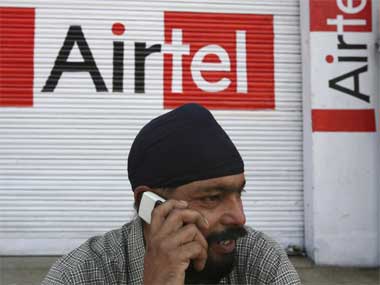The telecom numbers game is over. Consider the smoke signals:
On Friday, Bharti Airtel told its pre-paid subscribers that it would be raising tariffs by 20 percent. In one scheme based on per-minute billing, users will now pay 60 paise per minute (50 paise earlier) for local and STD calls, and 90 paise for calls to landlines. SMSes will cost Re 1 and Rs 1.50 for local and national.
The price war is over. Tata DoCoMo recently raised it SMS charges 66 percent. Others may wait and watch for a while, but if Airtel’s price hike sticks, they will rush to follow.
On Thursday, Communications Minister Kapil Sibal asked the Telecom Regulatory Authority of India (Trai) to formulate an exit policy for those who want to cut their losses and run. He has also called for new rules to facilitate mergers and acquisitions, apart from other sweeping changes in the telecom policy.
[caption id=“attachment_47332” align=“alignleft” width=“380” caption=“On Friday, Bharti Airtel told its pre-paid subscribers that it would be raising tariffs by 20 percent. Mukesh Gupta/Reuters”]  [/caption]
If Andimuthu Raja had become Communications Minister now, he would not have been able to collect big for laying out the welcome mat to newcomers.
A few days before Sibal asked Trai to open the exit door, there were glum faces all around when mobile subscriber figures showed steep declines.
BusinessLine reports that monthly subscriber additions had dropped 40 percent between February and June 2011. In February, mobile operators added a spiffy 14.7 million new subscribers. In June it was down to 8.6 million - the sharpest drop since 2004.
Impact Shorts
More ShortsActually, the writing on the wall should have been very clear even earlier. With a population of 1.2 billion, India has over 850 million mobile subscribers. This means three out of every four Indians has that little gadget in his hands. If one excludes the below-poverty-line cases, it means anyone who can afford a mobile phone has one, if not two, already. End of story.
It’s not that the horizontal expansion of subscribers will not continue. (Who knows, Sonia Gandhi’s NAC may include the right to own a mobile as its next focus area after food security.) Despite the slowdown in additions, India is likely to cross the one billion subscriber mark some time next year, overtaking (or running close) to the Chinese figures.
But, as one consultant points out, “even with a significant subscriber base, there is going to be a general lack of opportunity in the (Indian) market for the next couple of years relative to other markets.”
Reason: there’s no point having so many customers if they don’t spend enough. Chetan Sharma Consulting estimates the average revenue per user (ARPU) at around $3.5 (around Rs 150) - which explains why operators are unenthusiastic about improving service by investing in better networks. It also explains why Airtel thinks even Africa is a better market for growth.
Now that the realisation has sunk deep in the industry, that consumers have had it too good for a while, the focus is shifting to raising ARPUs. This is why Airtel is raising its tariffs. And when the market leader does that, you can be sure others will follow.
It also explains why Reliance Communications was so eager to exit from rural telephony, especially the one supported by the Universal Service Obligation Fund (USOF), for which it was fined by Kapil Sibal recently. Others are equally willing to flee, if given the opportunity.
From now on, consumers have to start expecting higher bills. The mobile operators will also be chasing richer customers for a while, to improve their ARPUs. Inclusive growth is pass. Exclusive service is for higher-paying customers.


)

)
)
)
)
)
)
)
)



